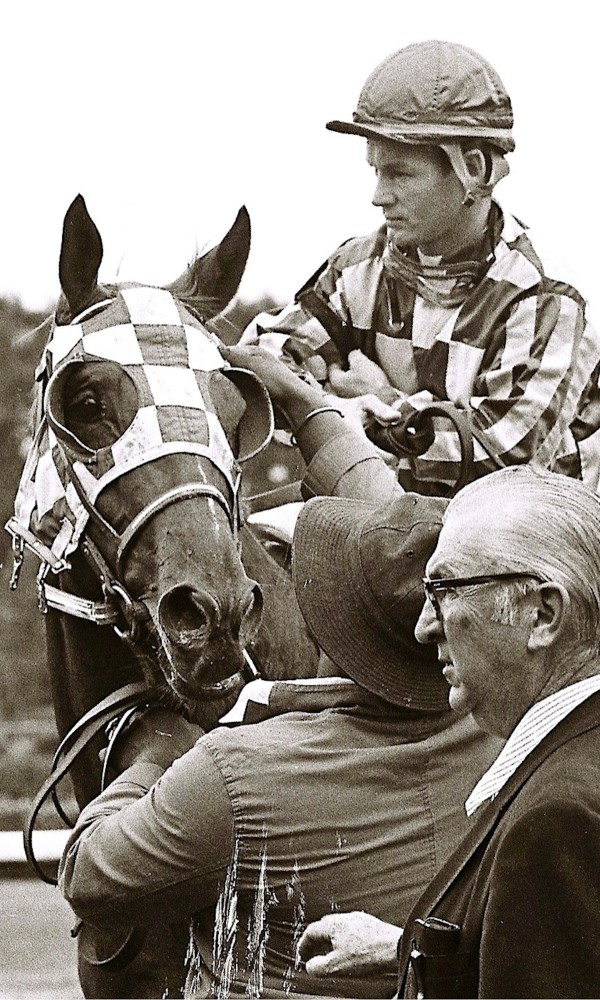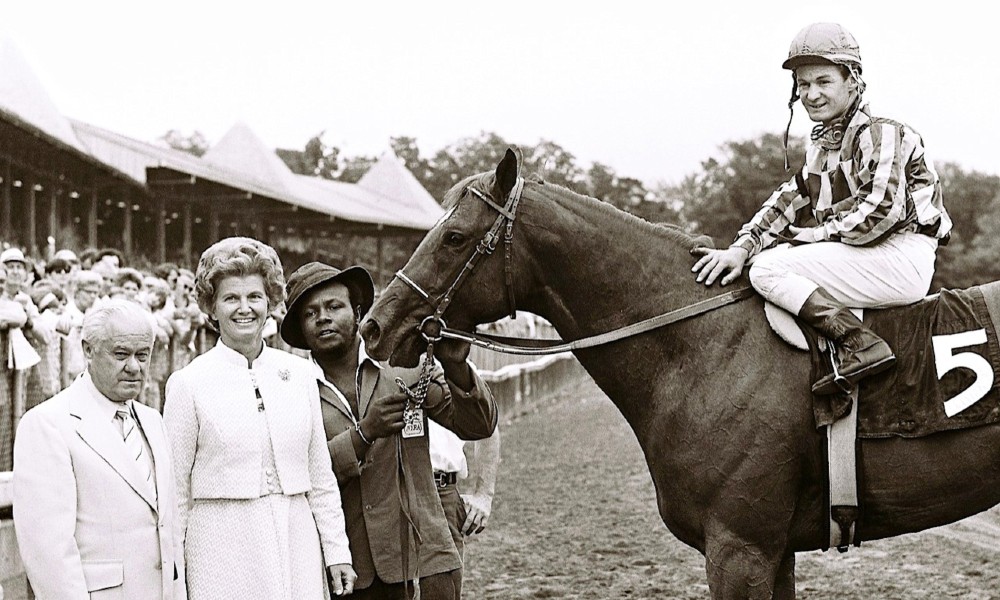Before he achieved immortal status in 1973 by winning the first Triple Crown in 25 years—setting records that still stand in the Kentucky Derby, Preakness Stakes and Belmont Stakes en route to becoming a cultural phenomenon—Secretariat became a superstar thanks to an extraordinary 2-year-old season that featured a trio of spectacular performances at Saratoga. So while the rest of the country will celebrate the golden 50th anniversary of his achievements in 2023, locally it’s more fitting to toast our four-legged national hero this year.
Secretariat would go on to inspire a legion of fans—and an award-winning Hollywood movie—but his fate was hardly cemented from birth. In fact, the woman who ushered him to greatness (played by Diane Lane in the film) had a 50/50 chance of not having him at all. By the time of Secretariat’s breeding, Penny Chenery had taken over the day-to-day operations of her family’s Meadow Stud stable after her father, Christopher, had begun experiencing health issues in 1968. She and the esteemed Phipps family had come to an agreement—one that would eventually benefit both parties, albeit in wildly different ways.
Bold Ruler was owned by the Phipps family and at the time had been North America’s leading sire since 1963. (Bold Ruler stood at the historic Claiborne Farm in Kentucky, but the Phipps family owned the majority of the mares to which the stallion was bred, so few of his progeny were ever sold at public auction.) To infuse new blood into their breeding program, the Phipps family on occasion negotiated foal-sharing agreements with other broodmare owners. In exchange for waving Bold Ruler’s stud fee, they would arrange multiple matings with the stallion—in Chenery’s case, matings with two of her mares in two consecutive years. On the assumption two foals were produced in a given year, the Phipps family would keep one and Chenery would retain the other. A coin toss was used to determine who got to choose their horse. Chenery (at the time known as Penny Tweedy, until her 1974 divorce) sent Hasty Matelda and Somethingroyal from her Virginia stable to be bred to Bold Ruler in 1968, and Cicada and Somethingroyal in 1969. The agreement stated that the winner of the coin toss would get first choice of the 1969 foals, while the loser would have to wait until 1970 to have first choice.

The history-making coin toss was held in the fall of 1969 in the office of NYRA Chairman Alfred G. Vanderbilt, Jr. Chenery actually lost the coin toss, but ended up winning in the end. Ogden Phipps chose the 1969 weanling filly, named The Bride, out of Somethingroyal. (The Bride never won a race but did later become a stakes producer.) This left Chenery with the Hasty Matelda colt. The next year, however, Cicada did not conceive, leaving Phipps empty-handed and Chenery, the coin toss “loser,” with the foal of Somethingroyal, which was due in the spring of 1970. He would be named Secretariat, and managing his career would change Chenery’s life. The Phipps family, meanwhile, did benefit from Chenery’s success, as Bold Ruler once again became North America’s leading sire in 1973 thanks in large part to Secretariat’s exploits.
The bright-red chestnut was born shortly after midnight on March 30, 1970, and joined trainer Lucien Laurin’s winter stable at Hialeah Park in Florida in early 1972. Secretariat quickly earned a reputation as a kind and intelligent horse and had a desired physique, but he was clumsy in his early training. After several months, however, Laurin believed the Meadow colt was ready to make his debut. Secretariat was a 3-1 favorite in his first career start at Aqueduct on July 4, 1972. At the start of the 5½-furlong contest a horse named Quebec cut in front of the field, causing a chain of events that led to Secretariat’s being bumped hard and shuffled back in the field of 12. More trouble ensued on the backstretch when Secretariat and jockey Paul Feliciano found significant traffic trouble. In 10th at the top of the stretch, Secretariat quickly made up significant ground on the leaders and finished fourth, beaten by Herbull by only 1½ lengths.
Eleven days later, Secretariat was favored at 6-5 going six furlongs in a field of 11 at Aqueduct. With Feliciano again in the irons, Secretariat broke poorly but proved to be superior to his competition, rolling to a six-length victory. The New York racing scene then transitioned upstate to Saratoga. At the Spa, Ron Turcotte, the regular rider for Meadow Stable, replaced Feliciano as Secretariat’s pilot.
At Saratoga, the legend of Secretariat began.
With Turcotte up, Secretariat earned an impressive allowance victory at Saratoga on July 31, covering six furlongs in 1:104⁄5 as the 2-5 favorite. “You carry an ideal around in your head, and boy, I thought, ‘This is it,’” legendary sportswriter Charles Hatten said after Secretariat’s first Spa victory. “I never saw perfection before. I absolutely could not fault him in any way. And neither could the rest of them and that was the amazing thing about it. The body and the head and the eye and the general attitude. It was just incredible. I couldn’t believe my eyes, frankly.”
Next up for Secretariat was the historic Sanford Stakes, a Saratoga fixture since 1913 that was notable as the only race Man o’ War ever lost. Secretariat did not suffer the same fate; his Sanford was a tour de force. Facing off with the highly regarded Linda’s Chief—the only horse ever to be favored against Secretariat—the emerging Meadow star had his work cut out for him in the stretch. Impeded by horses in front of him, Turcotte moved Secretariat through the field “like a hawk scattering a barnyard of chickens,” according to Daily Racing Form. At the finish, Secretariat was three lengths clear of Linda’s Chief. The final time for six furlongs was 1:10. Andrew Beyer, covering the race for the Washington Star, wrote, “Never have I watched a lightly raced 2-year-old stamp himself so definitively as a potential great.”
Secretariat was even better 10 days later in the Hopeful Stakes, which was first contested at Saratoga in 1903 and had been won by greats such as Regret, Man o’ War, Whirlaway, Native Dancer, Nashua and Buckpasser. For most of the Hopeful, Secretariat looked
to be out of contention.
“He was shuffled back to last place soon after the start,” the New York Times reported. “Secretariat, for all intents and purposes, was not in the hunt as the field hit into the stretch run.”
But that didn’t last long. “The achievement of Secretariat was made most remarkable, even in view of his expected triumph, by his lightning forward thrust,” the Times continued. “Suddenly, as if activated by coiled springs, Secretariat was up front, enjoying a head advantage over Sunny South. After that the Meadow Stable colt went his own way, extending his lead over his foes with every stride.”

At the finish line, Secretariat was five lengths in front of Flight to Glory for his fourth win in five starts. The time of 1:161⁄5 for 6½ furlongs was three-fifths of a second off the track record.
Turcotte said Secretariat “took himself back as he usually does right after the break. I let him settle into stride and he began to pick up on his own as we came up to the half-mile pole. By the time we straightened out, he was in front. Through the stretch he just kept reaching out without pressure.”
The Times added that Secretariat’s Hopeful win was achieved with “contemptuous ease” and the result “was a fitting one for the final program of the Saratoga season.”
Secretariat’s exploits at Saratoga confirmed his star status. He then made his Belmont Park debut on September 16, winning the prestigious Futurity by 1½ lengths. In October, Secretariat was favored at 7-10 in the Champagne. He flew past his rivals turning for home and crossed the finish line first by two lengths, but the stewards disqualified him for bearing in and interfering with Stop the Music, who was declared the winner. Secretariat was placed second. Two weeks later, Secretariat had no trouble trouncing Stop the Music by eight lengths in the Laurel Futurity. He then closed out his season November 18 with a 3½-length victory as the 1-10 favorite in the Garden State Futurity in New Jersey. Secretariat again dropped behind the field early before gobbling up his rivals turning for home. Laurin, not one to normally speak in reverential tones about young horses, was simply in awe of Secretariat’s talent.
“In all his races, he has taken the worse of it by coming from behind, usually circling his field,” the trainer said. “A colt has to be a real runner to do this consistently and get away with it.”
With a record of 7-1-0 from nine starts and earnings of $456,404, Secretariat was an easy choice for Champion 2-Year-Old Male in the balloting for the still-new Eclipse Awards, which were established in 1971, and, in a rare occurrence for a juvenile, was named Horse of the Year as well. Prior to Secretariat, only Commando (1900), Colin (1907), Native Dancer (1952) and Moccasin (1965) had earned pre-Eclipse Horse of the Year titles as a 2-year-old (Native Dancer and Moccasin were both co–Horse of the Year winners). Since the establishment of the Eclipse Awards, only Secretariat and Favorite Trick (1997) have won Horse of the Year as juveniles.
It was an enormous honor for a tremendous horse—a year before his Triple Crown clean sweep caught the attention of fans nationwide. And that is why in Saratoga, we’re celebrating Secretariat’s 50-year anniversary “early.” As for Chenery, after making a name for herself, in a field dominated by men, no less, she eventually left Virginia for Long Island and kept breeding and racing. Her horse Saratoga Dew made history by becoming the first New York–bred horse to win an Eclipse Award, another feather in her cap and nod to The Spa, the setting for Secretariat’s spectacular 1972 summer.


